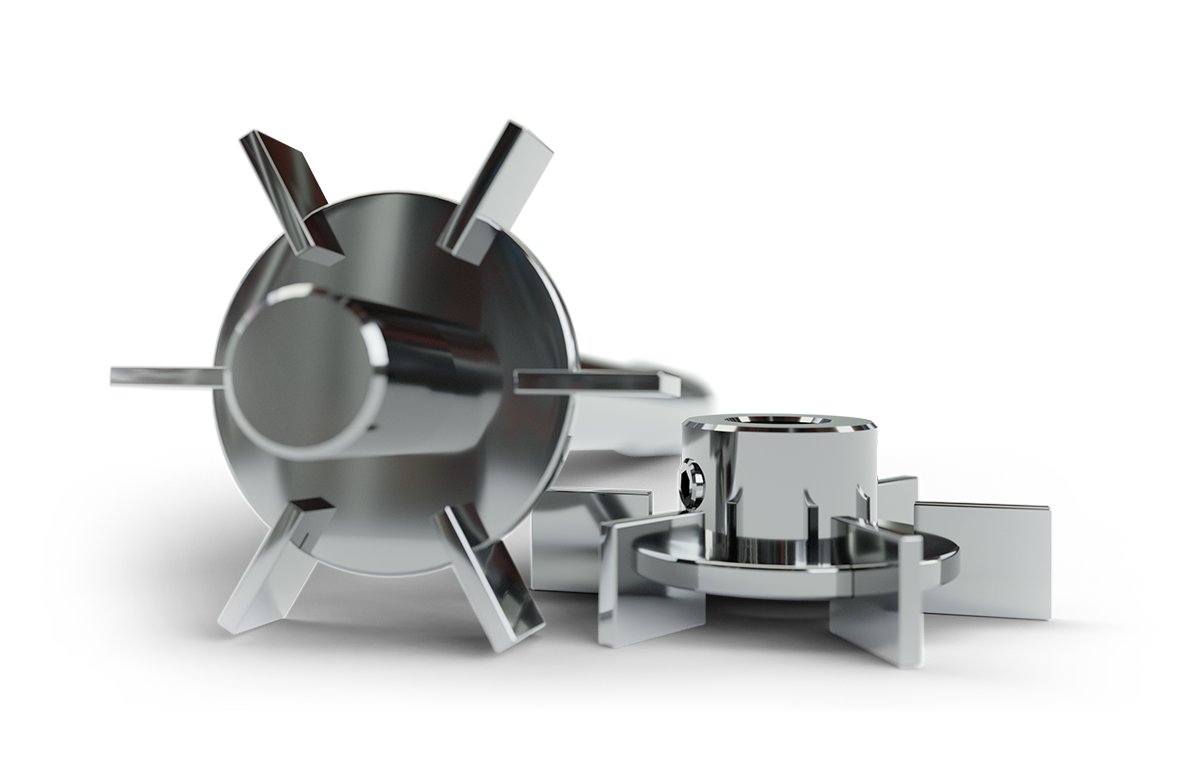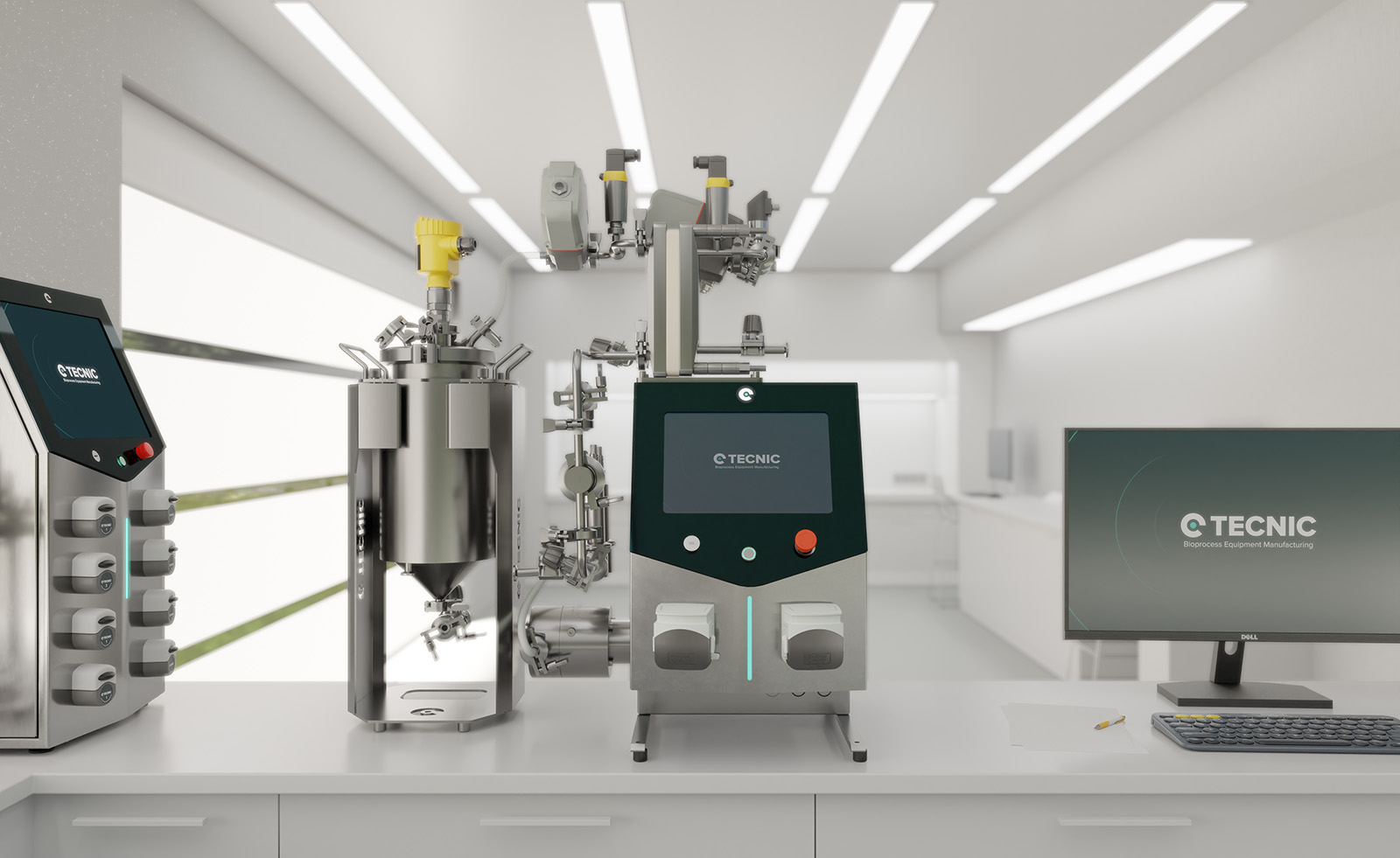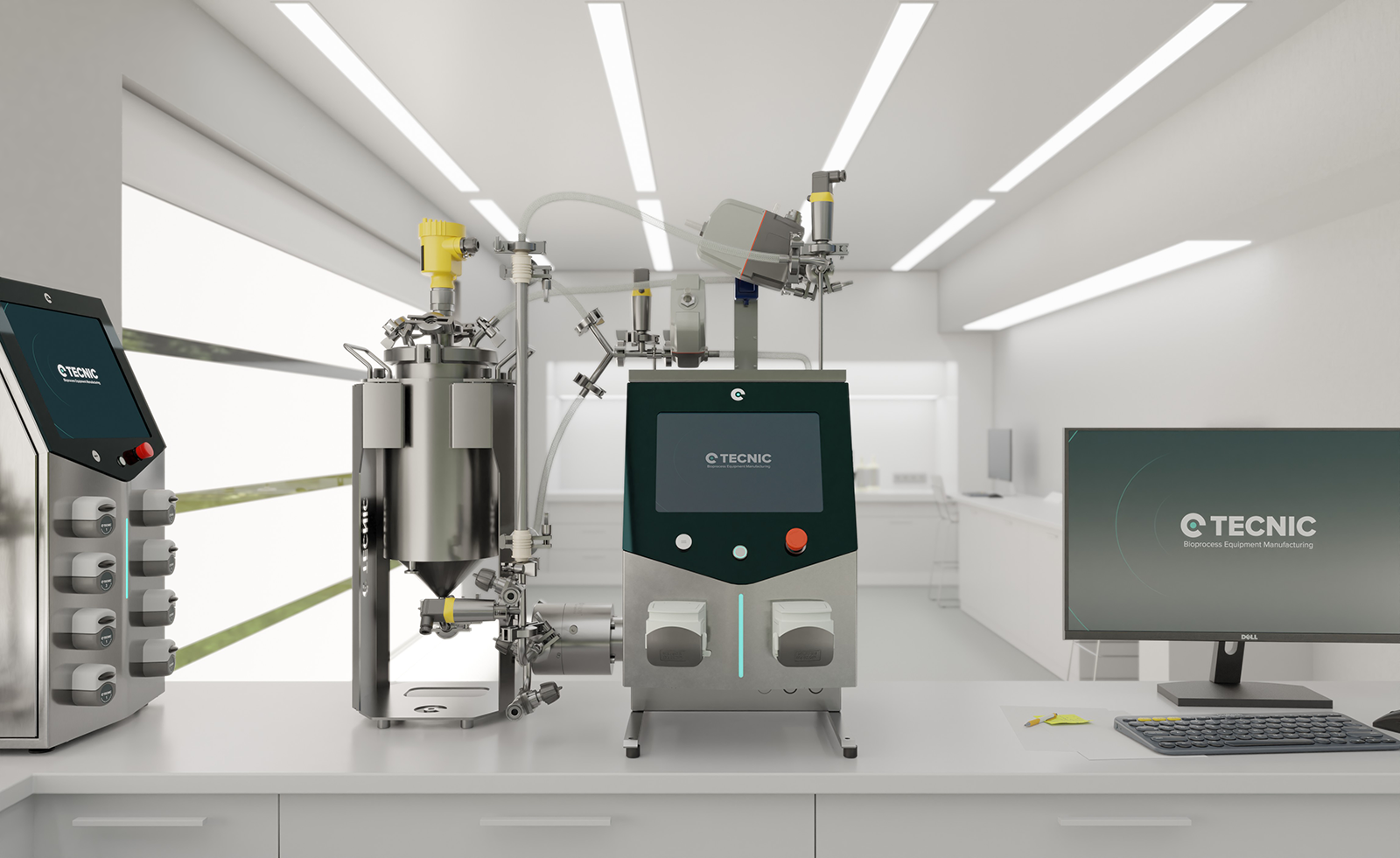¿How much science is behind your morning coffee?
Did you know that your daily cup of coffee is the result of a complex symphony of science and biotechnology? From the plant on the farm to the espresso on your table, biotechnology plays a role at every key stage. In this article, we explore, through a curious and informative tone, how science contributes to farming, fermentation processes, aroma development, and advanced industrial technologies that ensure the quality of your favorite drink.
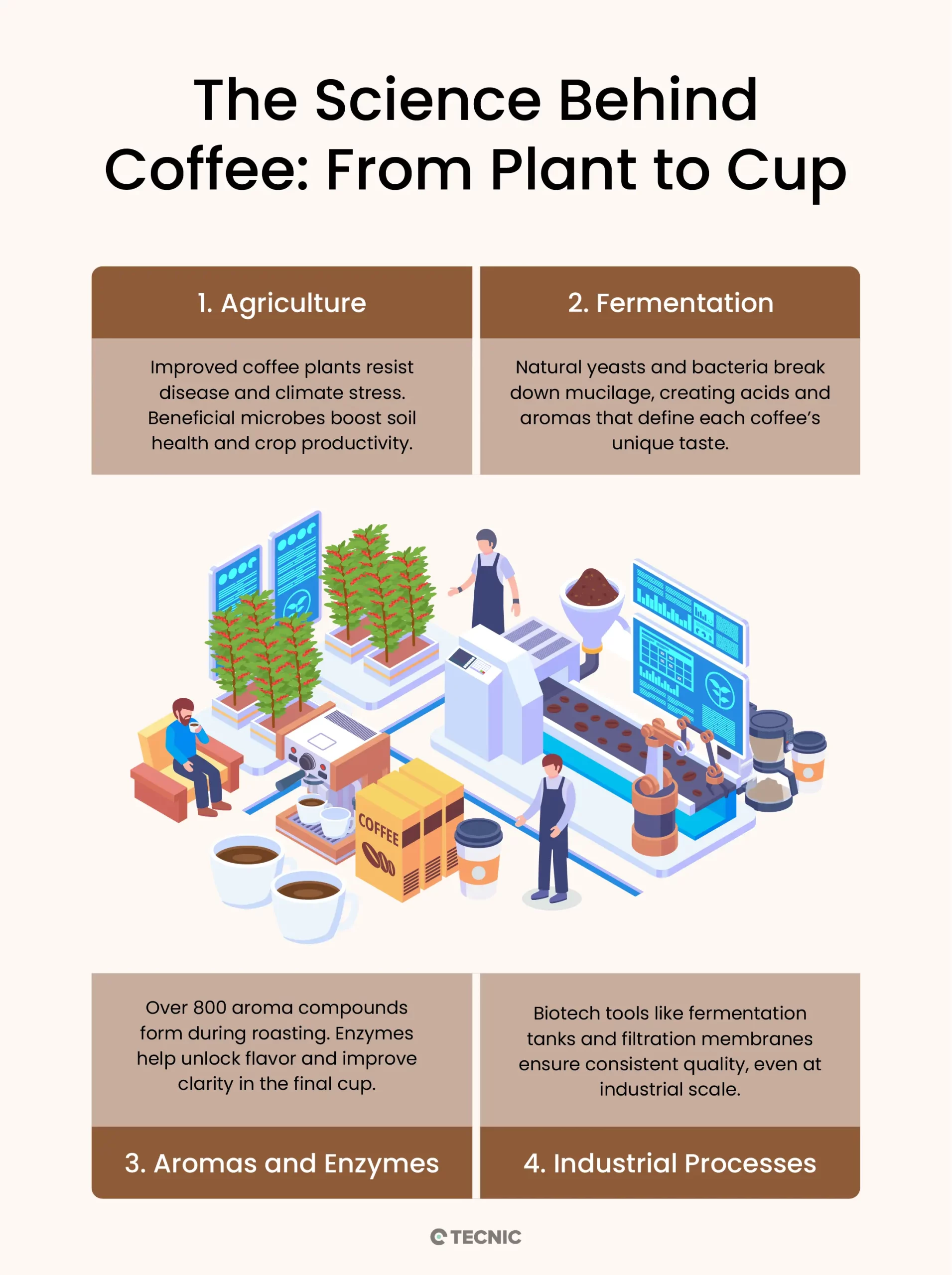
Agriculture: Biotechnological innovation from seed to plant
In the field, biotechnology helps genetically improve coffee plants to make them stronger and more productive. For example, genetic engineering techniques are already being used to develop varieties resistant to devastating diseases (like coffee leaf rust) and rising temperatures caused by climate change. Beyond transgenic methods, there are also innovative "non-GMO" approaches to create new hybrids.
In Mexico, scientists have successfully fused tissues from different plant varieties, one known for high cup quality and the other resistant to rust, using tissue culture, producing plants that combine the genetic information of both. This technique of “asexual grafting” accelerates the development of new varieties naturally and with greater genetic diversity, resulting in more vigorous shrubs protected against pests and diseases, without sacrificing flavor.
Agricultural biotechnology also works underground. The root of a coffee plant is surrounded by a universe of microorganisms (bacteria and fungi) living in the soil. Adding these microbes to the coffee rhizosphere improves crop health in several ways: enriching the soil by enhancing its structure and retaining nutrients, promoting stronger plant growth, and biologically controlling pathogens.
Some fungi and bacteria form symbiotic relationships with the roots, facilitating the absorption of nutrients like phosphorus and nitrogen, reducing the need for chemical fertilizers. Thanks to these players, biofertilizers and biocontrol agents, plantations can become more sustainable and resilient. In summary, from seed to mature shrub, genetic and microbial science is present to ensure that the crop grows healthy, productive, and ready to yield high-quality beans.

Fermentation: Microorganisms that enhance the flavor of every cup
After harvest, coffee beans (still wrapped in pulp and mucilage) go through a crucial process: fermentation. At this stage, a true team of microbial specialists comes into play. Various yeasts (genera like Saccharomyces, Torulopsis, Candida, Rhodotorula, among others) and lactic acid bacteria (such as Lactobacillus and Streptococcus) break down the sugary mucilage surrounding the bean.
These "sugar-devouring" microorganisms secrete enzymes that decompose complex molecules (pectins and pulp polysaccharides) into simpler compounds. In the process, they produce by-products like alcohols, organic acids, and carbon dioxide, and release aromatic molecules (aldehydes, ketones, esters) that infuse the bean with new flavor and scent notes. In other words, thanks to fermentation, green coffee develops sensory precursors that later, during roasting, become the beloved aromas and flavors in your cup.
Controlled fermentation has become a valuable tool for innovative producers. By adjusting variables such as time, temperature, and the type of microorganisms involved, it’s possible to highlight specific flavor profiles in the beverage. For example, some producers inoculate specific yeast strains (much like in winemaking) to achieve more fruity or floral notes.
Anaerobic fermentation (in tanks without oxygen) enhances certain acids and esters; aerobic fermentation (with oxygen) promotes different compounds. Each combination brings distinct nuances. By carefully controlling the process, producers and baristas can experiment with novel flavors, creating surprising and consistent sensory profiles that elevate the coffee experience. In short, behind that "special touch" in your morning coffee, there was likely a masterfully handled fermentation crafted to delight your palate.
Aromas and Enzymes: The aromatic chemistry of coffee and how it can be enhanced
If coffee wins us over, it's largely thanks to its captivating aroma. The scent of freshly brewed coffee is one of the most complex in the food world: over 800 different volatile compounds have been identified in coffee aroma. This wide range includes everything from terpenes (which provide floral or citrus notes) to pyrazines (responsible for roasted or nutty tones), along with aldehydes, esters, phenols, and many others.
Each aromatic molecule contributes a nuance: the right combinations yield fragrances of chocolate, fruits, spices, caramel, flowers… truly a chemical laboratory in every bean! Biotechnology helps us both understand and enhance this complexity. For instance, scientists use advanced analytical techniques (chromatography, biosensors) to identify which compounds and reactions during roasting produce the best aromas, information that is then used to optimize roasting and storage processes. Knowing that factors like genetic variety, processing method (washed/natural), and prior fermentation influence aromatic precursors has enabled producers to fine-tune those steps to highlight specific cup flavors.
The use of enzymes is another biotechnological contribution in the coffee processing stage. One illustrative case occurs during wet processing: traditionally, after depulping the cherries, the sticky mucilage was left to ferment until natural enzymes broke it down, a process that could take 18 to 36 hours depending on the climate. Nowadays, commercial enzyme blends (pectinases) are intentionally added to speed up mucilage removal from the beans, reducing the time to just a few hours (as little as 6 hours compared to the dozens needed with natural fermentation).
These enzymes rapidly break down pulp pectin, streamlining processing during high harvest periods. Likewise, enzymes are being explored to improve other aspects: for example, enzymatic treatments on green beans can subtly alter their chemical composition (by degrading certain proteins or sugars), which ultimately affects beverage quality. Some companies even use enzymes in soluble extract production to increase yield and reduce turbidity or sediment in the final product. In short, enzymes, produced by microorganisms or engineered in the lab, act as tiny molecular “tools” that fine-tune the flavor profile: making processing more efficient and contributing to a cleaner, more aromatic cup.

Industrial Processes: From the lab to your cup
When coffee production scales up from artisanal to industrial levels, biotechnology ensures quality is maintained in every batch. A clear example is the implementation of controlled large-scale fermentations at central processing facilities. In large plants, closed tanks are used where coffee ferments under constant supervision: beans flow continuously, with agitation systems to ensure homogeneity, monitored oxygen supply to keep aerobic bacteria alive, and periodic reinoculation of selected microorganisms to ensure fermentation remains vigorous.
All of this takes place in hygienic and controlled environments, almost like a laboratory, on the scale of thousands of kilograms of coffee, ensuring that regardless of quantity, each batch ferments optimally and uniformly. This level of biotechnological control reduces the risk of undesirable flavors and improves the consistency of cup quality for the end consumer.
In later industrial stages, various bioprocessing technologies ensure that every sip of coffee retains its best attributes. On one hand, we find equipment similar to those used in biotechnology: bioreactors and membrane filtration systems. Bioreactors, large stainless-steel fermentation tanks equipped with sensors, allow the scaling of biochemical processes while maintaining ideal conditions of temperature, pH, and aeration. For example, if a special fermentation or specific yeast inoculation is desired for an experimental coffee batch, an industrial bioreactor offers the perfect controlled environment.
Similarly, tangential flow filtration (cross-flow), commonly used in biotech to clarify cultures, finds relevant applications in the sector: it is used in processes like water-based decaffeination (to separate caffeine through membranes) or the recovery of essential oils and aromas from the infusion. These membranes separate compounds at the molecular level without adding off-flavors, preserving the purity of the extract. Technologies like these, provided by specialized companies such as TECNIC, help producers optimize production, whether by filtering extracts to make purer instant formulations or efficiently and sustainably reusing process water.
It’s not only today’s technologies that highlight science’s role; there are also futuristic developments worthy of science fiction. What if coffee didn’t come from a farm but from a bioreactor? In Finland, a group of scientists managed to grow plant cells in bioreactors through cellular agriculture, producing the first batches of “lab-grown brew” that smell and taste like conventional versions.
The process involves taking cells from a coffee plant and making them proliferate in a nutrient medium inside a bioreactor, then harvesting, roasting, and grinding the biomass. According to the researchers, the result in the cup was surprisingly familiar, confirming that even without beans, real coffee can be obtained.
Although this alternative approach is still experimental and not intended to replace traditional farming in the short term, it does show how far biotechnology can go in reimagining food production. It’s a sign that in the face of challenges like climate change or deforestation associated with coffee cultivation, science offers innovative solutions that may one day complement how we source our morning caffeine.
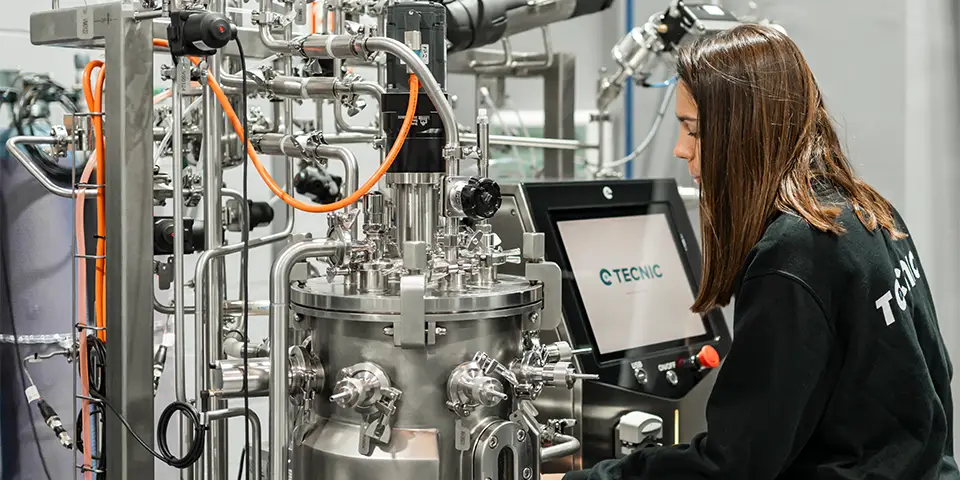
A sip of science in every cup
In conclusion, there is much more science behind every sip of your morning coffee than you might imagine. Biotechnology accompanies coffee at every stage: from resilient varieties and beneficial soil microorganisms, to microbial fermentations that enhance flavors, the development of complex aromas, the use of specialized enzymes, and the implementation of bioreactors and filtration systems in the factory.
The next time you enjoy that rich aroma and comforting taste, remember that you’re not just savoring the result of a farmer’s hard work, but also the outcome of countless scientific and technological contributions.
Frequently Asked Questions (FAQ)
It improves plant resistance and productivity using genetics and beneficial microbes in the soil.
Fermentation enhances aroma and flavor through the action of yeasts and bacteria.
Over 800 volatile compounds—like esters, aldehydes, and pyrazines—build the aroma profile.
Yes, enzymes speed up mucilage removal and enhance bean quality.
Bioreactors, fermentation tanks, and membrane filtration help scale and refine production.
Yes, Finnish scientists have grown coffee plant cells in bioreactors that taste like real coffee.
Absolutely. It allows producers to fine-tune flavors and achieve consistent, high-quality profiles.







